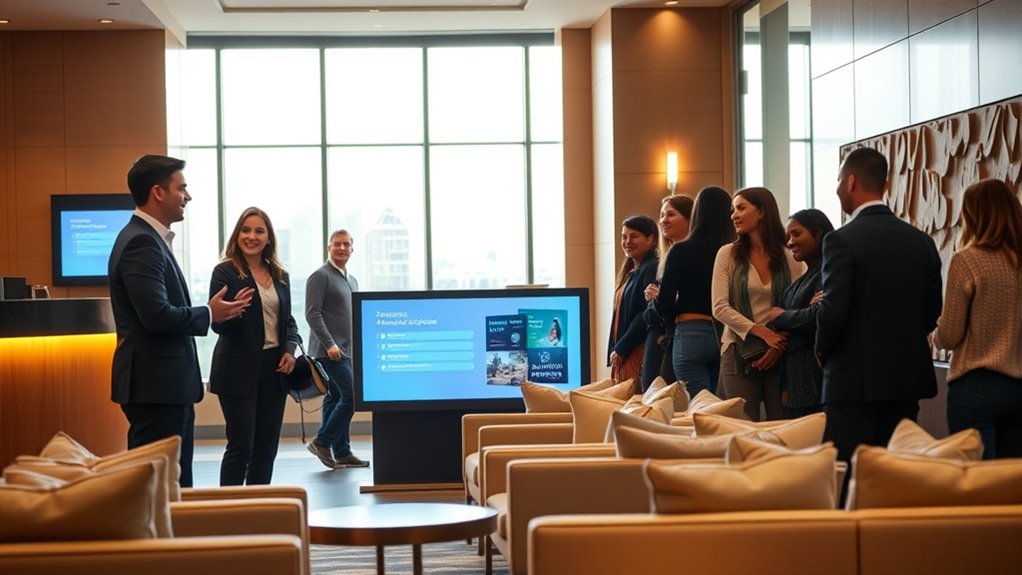By applying design thinking in hospitality, you focus on truly understanding your guests’ needs, desires, and pain points through empathy. This approach allows you to develop personalized, innovative experiences that create lasting impressions and foster loyalty. Engaging frontline staff and continuously improving services help you stay responsive and relevant in a competitive market. If you continue exploring, you’ll discover how these human-centered strategies can transform your guest experiences and build stronger emotional connections.
Key Takeaways
- Utilize guest empathy to identify needs, pain points, and preferences, informing personalized service design.
- Incorporate immersive observation and feedback collection to craft tailored guest experiences beyond standard offerings.
- Drive continuous innovation through guest insights, enhancing touchpoints like contactless check-ins and personalized amenities.
- Foster collaboration among staff to co-create solutions aligned with guest expectations and improve service quality.
- Build emotional connections by designing memorable, guest-centric journeys that promote loyalty and differentiate the brand.

Design thinking is transforming the hospitality industry by putting guest experience at the forefront of innovation. When you embrace this approach, you focus on understanding your guests’ needs, desires, and pain points, which allows you to develop more effective personalization strategies and service innovations. Instead of relying solely on traditional methods, you actively seek out insights through empathy, engaging with your guests on a deeper level. This shift enables you to create experiences that truly resonate, making your guests feel valued and understood.
With design thinking, you start by immersing yourself in your guests’ world. You observe their behaviors, listen to their feedback, and identify what matters most to them. This empathetic perspective helps you craft tailored solutions that go beyond generic offerings. Personalization strategies become a core part of your service approach, allowing you to customize experiences based on individual preferences—whether it’s adjusting room settings, offering personalized amenities, or curating local recommendations. This level of attentiveness leaves a lasting impression and fosters loyalty.
Immerse in guests’ world to craft personalized, memorable experiences that foster loyalty and leave lasting impressions.
Service innovation, driven by design thinking, becomes a continuous process. You challenge existing norms and experiment with new concepts that better serve your guests’ evolving needs. For example, you might implement contactless check-ins or develop apps that allow guests to personalize their stay in real-time. These innovations are not just technological upgrades; they are thoughtful responses to guest feedback and insights, ensuring that each touchpoint is meaningful. By iterating quickly and learning from each interaction, you keep your offerings fresh and relevant. Additionally, integrating advanced projector technology can elevate in-room entertainment and presentations, creating immersive experiences that delight your guests.
You also recognize that successful service innovation depends on collaboration. You bring together your team—front desk staff, housekeepers, chefs, and managers—to co-create solutions. Their frontline insights are invaluable in refining your ideas and ensuring they align with actual guest expectations. This collaborative approach fosters a culture of continuous improvement, where every team member feels invested in delivering exceptional, personalized experiences.
Ultimately, adopting design thinking in hospitality helps you stand out in a competitive market. You’re not just offering a place to stay; you’re creating memorable journeys tailored to each guest’s story. By prioritizing empathy, personalization strategies, and service innovation, you build strong emotional connections that turn first-time visitors into loyal advocates. This human-centered focus guarantees your hospitality business remains relevant and responsive, setting new standards for guest satisfaction in an ever-changing industry.
Frequently Asked Questions
How Can Small Hotels Implement Design Thinking Effectively?
You can implement design thinking effectively by starting with personalization strategies that focus on your guests’ needs and preferences. Train your staff to adopt an empathetic mindset, encouraging active listening and problem-solving. Engage your team in brainstorming sessions to develop innovative ideas tailored to your guests. Continuously gather feedback, iterate, and refine your approach, ensuring that every touchpoint feels personalized and memorable, ultimately enhancing guest satisfaction.
What Are Common Challenges Faced When Applying Empathy in Hospitality?
You might face challenges like cultural barriers that hinder understanding and communication gaps that cause misinterpretations. These issues make it harder to genuinely empathize with your guests’ needs. To overcome them, actively listen, ask open-ended questions, and learn about different backgrounds. By doing so, you build trust and create more personalized experiences, ensuring your empathy efforts truly resonate and improve guest satisfaction.
How Does Design Thinking Differ From Traditional Guest Service Approaches?
Design thinking differs from traditional guest service approaches by focusing on deep empathy and understanding your guests’ needs. You use personalization strategies to tailor experiences and foster emotional engagement, creating meaningful connections. Unlike standard methods that follow fixed procedures, design thinking encourages creative problem-solving and iterative feedback, allowing you to innovate continuously. This approach makes your service more responsive, memorable, and aligned with what your guests truly value.
What Tools Facilitate Empathy in the Hospitality Industry?
You can facilitate empathy in hospitality by using tools like customer journey maps and emotional mapping. These tools help you understand guests’ feelings and experiences at each touchpoint, revealing pain points and moments of delight. By actively analyzing this data, you can tailor services to meet emotional needs, creating a more personalized and memorable experience. Implementing these tools encourages genuine understanding and improves overall guest satisfaction.
How Is Guest Feedback Integrated Into the Design Thinking Process?
Imagine you’re back in the Victorian era, but today, you turn guest feedback into gold. You actively gather and analyze guest feedback through surveys, reviews, and direct conversations, then use this data to inform and refine your designs. This process supports continuous improvement, ensuring your services evolve with guest needs. By integrating feedback at every step, you create a more empathetic, personalized experience that truly resonates with your guests.
Conclusion
As you embrace design thinking in hospitality, you’ll realize that empathy and innovation often lead to unexpected connections—like a simple smile transforming a guest’s stay or a small detail sparking loyalty. Sometimes, it’s the tiniest insights that reveal the biggest opportunities for improvement. When you prioritize guest experiences with an open mind, you might just find that the most memorable moments come from the most surprising coincidences. It’s these serendipitous touches that truly elevate hospitality.








